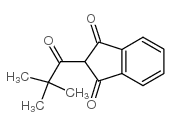Effect of the anticoagulant, pindone, on the breeding performance and survival of merino sheep, Ovis aries.
Michael H Robinson, Laurie E Twigg, Stuart H Wheeler, Gary R Martin
Index: Comp. Biochem. Physiol. B Biochem. Mol. Biol. 140(3) , 465-73, (2005)
Full Text: HTML
Abstract
The effect of the anticoagulant, pindone, on the breeding performance and survival of relatively free-ranging merino sheep was assessed. Pindone (2-pivalyl-1, 3-indandione) was administered orally as a single (10, 3, or 2 mg pindone kg(-1) over three consecutive days) or multiple exposure (dosing regime repeated after a further 8 days). Prothrombin times (PT) increased up to 4-fold in treated sheep, and haemorrhage occurred in some instances, particularly with the double dose treatment. Deaths of sheep also occurred, usually when the sheep were placed under added stress, particularly that associated with shearing. The breeding performance of pregnant ewes dosed with pindone was reduced, mainly due to an increase in stillborn and nonviable lambs (i.e. deaths within 2 days of birth). The motility of sperm in treated rams was also affected. Pindone persisted in the blood (maximum, 13.2 mg L(-1)) for up to 14 days after the last dose, and the half-life (t1/2) was estimated at approximately 5 days depending upon the dosing regime. Other tissue residues ranged from 17 (fat) to 39 (liver) mg kg(-1). The implications of these findings for ongoing responsible use of pindone (anticoagulants) in pest control programs are also discussed.
Related Compounds
| Structure | Name/CAS No. | Molecular Formula | Articles |
|---|---|---|---|
 |
NSC 31211
CAS:83-26-1 |
C14H14O3 |
|
Analysis of indandione anticoagulant rodenticides in animal ...
2008-12-05 [J. Chromatogr. A. 1213(1) , 77-82, (2008)] |
|
[Mutagenic effect of pindone on D. melanogaster].
1993-04-01 [Boll. Soc. Ital. Biol. Sper. 69(4) , 237-41, (1993)] |
|
Vitamin K and its therapeutic importance.
1982-06-01 [J. Am. Vet. Med. Assoc. 180(11) , 1354-6, (1982)] |
|
Assessment of the potential toxicity of a poison for rabbits...
1991-07-01 [Aust. Vet. J. 68(7) , 241-3, (1991)] |
|
The anticoagulant pindone causes liver damage in the brushta...
1994-07-01 [Aust. Vet. J. 71(7) , 220, (1994)] |